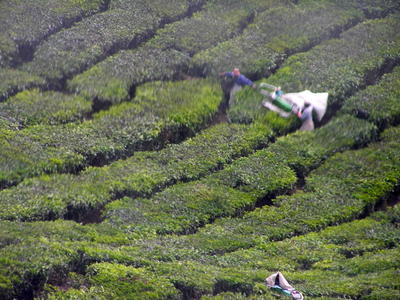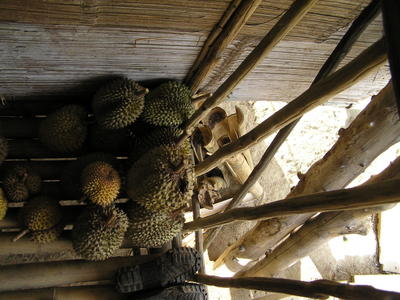

When you agree to go on an organised excursion, it is very difficult to know whether you have got yourself into some kind of little tourist type roadshow - whiz by the sights, stop off at the gift shop (t-shirt and postcard?) see you next time - or if you will actually pay for a unique experience - the sort of things that you simply wouldn’t be able to have in nearly the same way on your own. With this in mind, it was with some hesitation that we decided to take an organised tour around the Cameron Highlands, the sort of tours we have been avoiding this trip. Our intuition was that this was one trip that would be a good one, more than a simple tourist experience, and thankfully we right.
The Cameron Highlands happens to be one of the few places we had actually heard about before we arrived in Malaysia, though it didn't seem like it would fit with the extreme beach relaxation concept we initially envisioned as we started out. But plans evolve. The description in our faithful Lonely Planet guidebook, along with the recollection of the recommendation offered by a friend of Elisabeth’s siter who had been here a few years back was convincing.
The Cameron Highlands, most of which is around 1800 metres above sea level, has a rather cooler and significantly less humid climate than the rest of Malaysia - not unlike Denmark in the summer in fact. Some days are rather cool, some days are sunny and rather hot and there is quite a bit of clouds and rain. The majority of Malaysia’s fruit, vegetable, tea and cut flowers are produced here, which is not hard to understand was once you are here. It is not that large of an area, but the place is a model of efficiency and organisation in the sense that every bit of possible farming land is producing non-stop 12 months of the year with the assistance of copious amounts of fertilizer.

before the tomatos are fully ripened, a new row of beans (I believe they are...) is already planted below

orchids for everyone...

the yellow lady orchid - up close...
Allow me a small digression.
If anyone has ever had the chance to see that rather famous photo exhibition of photos by Yann-Arthurs Bertrand, called ‘The Earth From Above’ - which is quite likely as it has been everywhere in the past five years - I myself have seen it in no less than 3 cities. It is an exhibition which unavoidably leaves the strongest of impressions the first time you see it for the simple reason that he captures a seemingly endless number of timeless moments in time from around the globe in the most vivid detail and colour, and all looking down from above. Inevitably there are countless scenes which even the most well-travelled of person has never witnessed.
But back to our little excursion. Seeing the endless tea plantations of the Cameron Highlands brought back memories of a pictures from the ‘Earth From Above’ exhibtion taken of the Malaysian tea plantations. I could see the picture in my minds eye immediately. Nonetheless, the sight of this landscape in real life, as Elisabeth remarked, was one beyond anything that exists in any memory-bank of images from places we had ever encountered in our life. Utterly unique.

endless valleys of tea

cutting and collecting the tea leaves

tea trees
Seeing the actual tea production process, though interesting, was actually an anti-climax after all the rest.
However this was only a part of the experience. The trip to an Orangi Asli village in the junge was undisputedly the highlight of the day.
As was explained to us, we were able to visit this village not because it was part of any existing tourist route, but rather because one of the people from this village was worked at the hostel where we were staying, which was how the agreement to conduct tours through the village came about.
A bumpy trip in a Land Rover into the jungle, a short walk over a bridge to the village got us there.

the Orang Asli village from a distance...

Now obviously the people in this village are used to westerns by now, which didn’t detract at all from the utter uniqueness of the experience, because in any event, there lives are an odd combination of traditional living combined with a certain moderness. The visit began by giving the kids some biscuits we had brought along.

the welcome was really for the biscuits we brought, not us!
The village huts are traditional, made of bamboo and only lasting 2-3 years.

The Chief's hut...
We were invited into the hut of the villlage chief for tea, tapiocca and a unique a rather smelly fruit, durion (very smelly, acquired taste which I didn't quite acquire). Undisputably a unique and fascinating experience.

the infamously smelly durion fruit

the village chief

The village chief, incidently, is elected democratically by his tribe, and resigns his position voluntarily when he feels he has nothing more unique to offer his tribe as its chief, at which point a new chief is elected.
However, as I mentioned, there is a clear intrusion of the modern with their very traditional way of living. In this small 14 family village set inside the jungle, this included running water piped in, a gas stove and in the chiefs hut, even a television and DVD player powered by a solar power.

a modern jungle kitchen...

a modern jungle entertainment system...

a modern solar panel...
Many of the Orang Asli people have taken the government offer of significant subsidies in the form of free houses along with electricity and water if they move out of the jungle and into nearby villages. The Orang Asli are actually Christian, though the government would love to see them convert to Islam, hence the efforts being made to move them closer to the rest of the Malaysian society. Orang Asli children, once they turn 15 or 16 are encouraged to move to the town away from their village to see whether this way of life interests them. Most opt to return to their jungle villages, though some obviously stay in the towns and cities.
I will let the rest of the pictures tell the remaining story of our little visit.

the chiefs chicken, sitting on its eggs - yes, inside the hut!

hunting traps

a blow pipe, firing a small wooden dart laced with a deadly poison on the tip. A small blow fires the dart up to 50 metres!


yes, cute everywhere...

a friendly game of dodgesandle
No comments:
Post a Comment